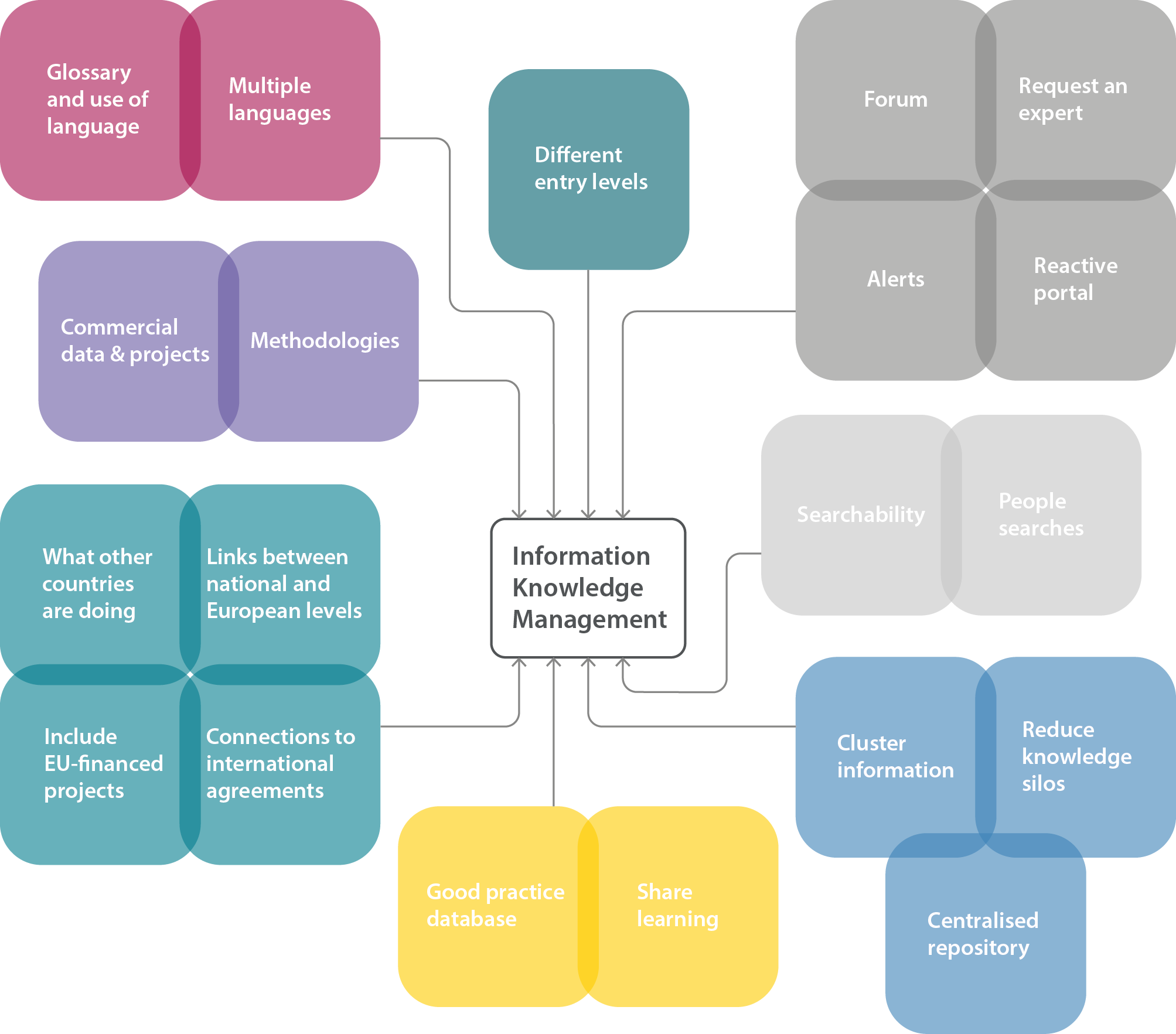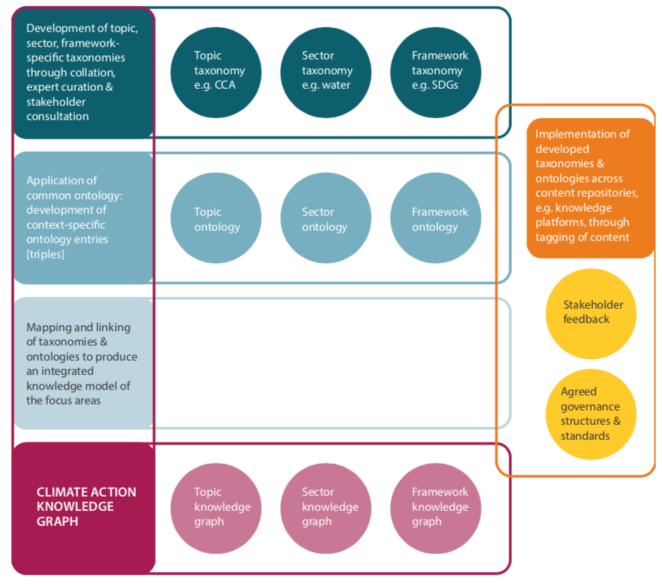Article /
Transforming knowledge management for climate action: A road map for accelerated discovery and learning

Introduction
To address the urgent, existential threat posed by climate change, and to achieve a just and inclusive transition to a net-zero carbon economy by 2050 (EC, 2019), will require a transformation in how the world seeks and finds the information to address these enormous, interrelated missions. Thus, a half a century after the dawn of the Information Age, the new imperative is to move forward from having information to harnessing it.
A rethink of one basic, often neglected aspect of work – knowledge management standards and practices – has the power to both open up and speed up access to knowledge throughout the globe with potentially transformative effects.
This paper, produced as part of the EU H2020 PLACARD project, presents a road map forward on these issues. It outlines how taking basic steps to change the conduct of a basic organisational practice – information and knowledge management (IKM) – can accelerate action on climate change. Our focus here is on actions that reduce the impacts of climate change – specifically by supporting adaptation to climate change and reduction of disaster risk.
As part of this work we have begun building taxonomies for CCA & DRR. Find out more about this work and future steps here.
*Download the full publication from the right hand column. The key messages from the publication are provided below. See the full text for much more detail.
Key messages
- To an unprecedented degree, people are generating huge amounts of data, information, and knowledge for two key, global missions: addressing climate change, and achieving the sustainable development goals. Harnessing and leveraging such information are urgent tasks.They require a new mindset, investment in key management practices, and the collective will to operate in ways that make finding and sharing information easier.
- Previous efforts to classify, categorise and structure climate-relevant knowledge as needed have failed to reach their full potential – or their intended audiences. As a result, people cannot easily and rapidly find the information they seek. When they do find information, they often cannot understand it – and thus cannot use it.
- Information Knowledge Management (IKM) offers a viable way forward. IKM technologies at hand and on the horizon have the power to connect and analyse vast amounts of climate-relevant data and information in ways that previously were not possible. .
- Progress largely hinges on the adoption and use of universal, standardised IKM practices by relevant organisations, governments, the private sector, civil society, and the research community. Some standards already exist; others must be developed.
- The advent of the IKM technologies and the use of practices outlined in this paper can transform the Internet into a true global database that is up to the global missions at hand. The use of these tools and practices can lay the foundation for further advances from artificial intelligence (AI) approaches now on the horizon.
- This paper serves as a siren call for greater leadership and funding, and for summoning the collective will to create a step change in the prevailing conduct of fundamental IKM practices.
How to begin: steps to take now
Platforms, portals, projects, and organisations sharing content relating to climate action can already start preparing and contributing towards an integrated and unified view of heterogeneous knowledge relating to climate action by:
- Following existing good practice principles and standards where possible.Examples of such measures include “open government” principles, World Wide Web Consortium (W3C) standards, and FAIR principles (Wilkinson et al., 2016); and for taxonomies and ontologies, the Simple Knowledge Organization System (SKOS), and Web Ontology Language (OWL) standards.
- Sharing existing taxonomies and ontologies (both formal and informal) with one anotherto support widespread uptake and use, and to provide an moverview of the terminology being used in different focus areas and within different websites. Where possible, joint mapping exercises can be used to (a) “link” existing terms (concepts) between the taxonomies, and (b) expand metadata associated with terms (such as their synonyms).
- Engaging experts to validate and improve taxonomiesby adding missing terms, metadata, and information on how the terms in the taxonomies behave and relate to each other (their semantics) to produce ontologies. Metadata can include definitions from each community on the use of terms, as well as “scope notes” that describe context-specific use (and, importantly, excluded uses) to help non-experts understand and apply technical terms.
- Adopting and implementing shared taxonomies and ontologies within their websitesto tag content with relevant key terms. A free to use tagging tool, such as the Climate Tagger, which also enables retrospective tagging of large datasets, could support this step.
- Developing application programming interfaces (APIs), to support interoperability and content sharing across websites.
- Promoting awareness of the added value and importance of IKM within and across institutions in supporting knowledge uptake, informing decisions, and enabling powerful analysis using AI approaches.
How to advance: steps to take over the medium and long terms
The goal is to use the shared taxonomies and ontologies for the development of a more comprehensive and sophisticated tool, a climate action knowledge graph. A knowledge graph is a model of a knowledge domain comprising concepts, classes, properties, relationships and entities covering multiple domains, various levels of granularity, and data from multiple sources.
The activities advocated here involve the development of taxonomies and ontologies that follow SKOS and OWL standards. They require specialised expertise. As such, an initial step for all actors involved is to assess current capacity and literacy for this work, and to engage with IKM (specifically taxonomy and ontology) professionals to address capacity gaps.
- Collate and evaluate existing taxonomies and ontologies in relevant focus areas (topic, sector, policy framework).
- Collate all the different data, knowledge and information types that the shared taxonomy and ontology need to describe and relate.
- Conduct interviews and hold workshops with stakeholders to further explore the nature of content, terminologies and users’ information and knowledge needs, including the design of IKM systems and knowledge integration.
- Share, discuss and use outputs from steps 1-3 to explore significant overlaps in terminology and to establish components of a common ontology.
- Specify a set of (prioritised) core IKM activities that taxonomies, a common ontology, and the resulting overarching knowledge graph should support.
- Agree on standards for quality assurance, metadata, and governance of the taxonomies, common ontology, and knowledge graph, and make key decisions about their licensing and publishing.
- Agree on standards for the implementation and use of the shared taxonomies and common ontology to connect relevant content across websites, enable accurate clustering of knowledge for different decision-making contexts and ensure the linked data content pool is of sufficient quality to be useful to users.
- Develop a governance model that specifies how future changes and enrichments of taxonomies, common ontology and resulting knowledge graph will take place.
- Develop a common ontology framework to attribute characteristics to terms and describe the relationships between terms.
- Develop the focus area taxonomies and ontologies based on existing taxonomies and ontologies and their overlaps, the common ontology framework, the terminology used in that area, the content types that need to be described and the needs of stakeholders.
- Enrich and expand the taxonomies and ontologies through text analysis of documents, websites, and other content to identify new terms for integrating into the taxonomy.
- Add metadata to the focus area taxonomies to provide a rich base of information on the terms, including definitions and how they are used in different contexts.
- Analyse overlaps and, where appropriate, link the focus area taxonomies and ontologies to produce an integrated, shared climate action taxonomy and ontology.
- Implement the integrated taxonomy and ontology in knowledge management systems to produce a knowledge graph of climate action.
- Continue to enrich and expand the taxonomies, ontologies, and resulting overarching knowledge graph.
- Regularly test and evaluate the taxonomies, ontologies, and resulting knowledge graph and explore their potential to better support users, including through AI approaches and the development of “‘smart”, responsive IKM systems.
This road map provides an achievable pathway for transforming IKM to make the most of the vast array of climate-related knowledge already at hand but currently scattered across various sectors, communities of research and practice, organisations, governments, and private sectors. These basic changes in organisational practices have transformative power.
Leadership and funding sufficient to direct and support collaborative action from the community are paramount. A European Union secretariat dedicated to enhancing IKM for climate change and sustainable development agendas could provide this.
*Refer to the full publication for more details on the participation and leadership required from actor groups and the community for every step.

This paper has been produced as part of the PLACARD project: Expanding the information and knowledge management framework to support sustainable institutional cooperation in CCA and DRR.
Suggested citation
Barrott, J., Bharwani, S. and Brandon, K. 2020. Transforming knowledge management for climate action: a road map for accelerated discovery and learning. PLACARD project, FC.ID: Lisbon.
Further reading
Related resources
- About PLACARD
- The PLACARD taxonomies for CCA & DRR: Development note and future work
- The PLACARD Connectivity Hub: A new ‘search and discovery’ tool for CCA and DRR
- PLACARD Brief - "Words matter: using language and technology to better inform the CCA and DRR communities"
- PLACARD webinar: Transforming knowledge management for climate action
- The Knowledge Graph Cookbook
